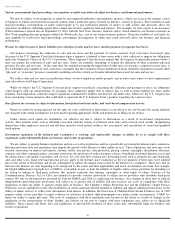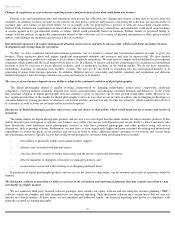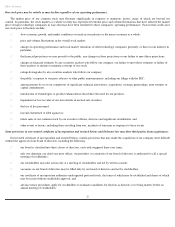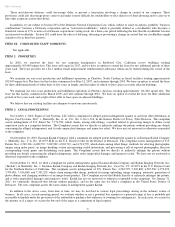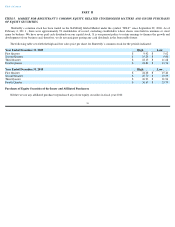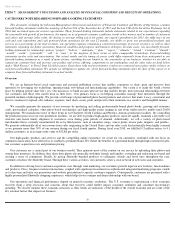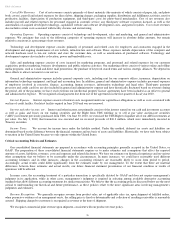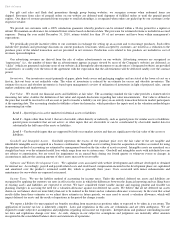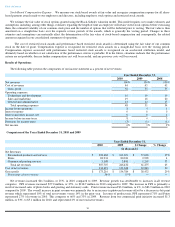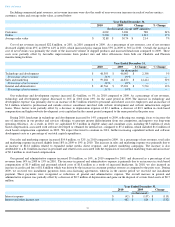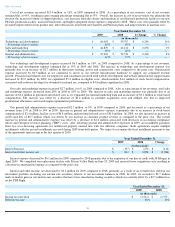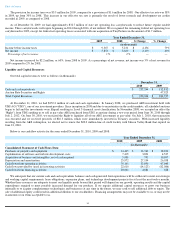Shutterfly 2011 Annual Report Download - page 32
Download and view the complete annual report
Please find page 32 of the 2011 Shutterfly annual report below. You can navigate through the pages in the report by either clicking on the pages listed below, or by using the keyword search tool below to find specific information within the annual report.
Cost of Net Revenues.
Cost of net revenues consists primarily of direct materials (the majority of which consists of paper, ink, and photo
book covers), payroll and related expenses for direct labor, shipping charges, packaging supplies, distribution and fulfillment activities, rent for
production facilities, depreciation of production equipment, and third-party costs for photo-
based merchandise. Cost of net revenues also
includes payroll and related expenses for personnel engaged in customer service, any third-
party software or patents licensed, as well as the
amortization of acquired developed technology, capitalized website and software development costs, and patent royalties. Cost of net revenues
also includes certain costs associated with facility closures and restructuring.
Operating Expenses.
Operating expenses consist of technology and development, sales and marketing, and general and administrative
expenses. We anticipate that each of the following categories of operating expenses will increase in absolute dollar amounts, but remain
relatively consistent as a percentage of net revenues.
Technology and development expense consists primarily of personnel and related costs for employees and contractors engaged in the
development and ongoing maintenance of our website, infrastructure and software. These expenses include depreciation of the computer and
network hardware used to run our website and store the customer data, as well as amortization of purchased software. Technology and
development expense also includes co-location, power and bandwidth costs.
Sales and marketing expense consists of costs incurred for marketing programs, and personnel and related expenses for our customer
acquisition, product marketing, business development, and public relations activities. Our marketing efforts consist of various online and offline
media programs, such as e-
mail and direct mail promotions, the purchase of keyword search terms and various strategic alliances. We depend on
these efforts to attract customers to our service.
General and administrative expense includes general corporate costs, including rent for our corporate offices, insurance, depreciation on
information technology equipment, and legal and accounting fees. In addition, general and administrative expense includes personnel expenses
of employees involved in executive, finance, accounting, human resources, information technology and legal roles. Third-
party payment
processor and credit card fees are also included in general and administrative expense and have historically fluctuated based on revenues during
the period. All of the payments we have received from our intellectual property license agreements have been included as an offset to general
and administrative expense. We recognized a final payment due from one of the agreements in the first quarter of fiscal year 2010.
Interest Expense.
Interest expense consists of interest costs recognized under our capital lease obligations as well as costs associated with
our line of credit facility. Our latest facility expired in June 2010 and was not renewed.
Interest and other income, net
. Interest and other income, net primarily consists of the interest earned on our cash and investment accounts
as well as gains and losses on our trading securities and the Right from UBS entitling us to sell at par value auction-
rate securities
("ARS") investment previously purchased from UBS. On June 30, 2010, we exercised the UBS Right to liquidate all of our ARS investments at
par value. On July 1, 2010, that transaction was executed and we received proceeds of $26.3 million, which were immediately invested in
Treasury securities.
Income Taxes.
We account for income taxes under the liability method. Under this method, deferred tax assets and liabilities are
determined based on the difference between the financial statement and tax basis of assets and liabilities. Historically, we have only been subject
to taxation in the United States because we only operate within the United States.
Critical Accounting Policies and Estimates
Our consolidated financial statements are prepared in accordance with accounting principles generally accepted in the United States, or
GAAP. The preparation of these consolidated financial statements requires us to make estimates and assumptions that affect the reported
amounts of assets, liabilities, revenues, costs and expenses and related disclosures. We base our estimates on historical experience and on various
other assumptions that we believe to be reasonable under the circumstances. In many instances, we could have reasonably used different
accounting estimates, and in other instances, changes in the accounting estimates are reasonably likely to occur from period to period.
Accordingly, actual results could differ significantly from the estimates made by our management. To the extent that there are material
differences between these estimates and actual results, our future financial statement presentation of our financial condition or results of
operations will be affected.
In many cases, the accounting treatment of a particular transaction is specifically dictated by GAAP and does not require management’
s
judgment in its application, while in other cases, management
’
s judgment is required in selecting among available alternative accounting
standards that allow different accounting treatment for similar transactions. We believe that the accounting policies discussed below are the most
critical to understanding our historical and future performance, as these policies relate to the more significant areas involving management’
s
judgments and estimates.
Revenue Recognition.
We generally recognize revenue from product sales, net of applicable sales tax, upon shipment of fulfilled orders,
when persuasive evidence of an arrangement exists, the selling price is fixed or determinable and collection of resulting receivables is reasonably
assured. Shipping charged to customers is recognized as revenue at the time of shipment.
We recognize commercial print revenue upon shipment, consistent with our product revenue policy.
Table of Contents
28


